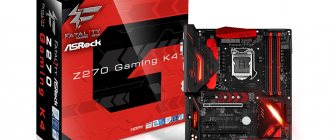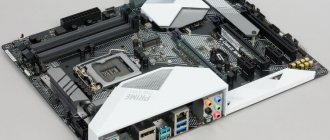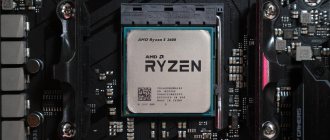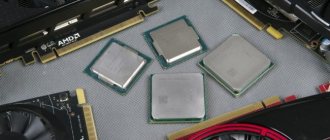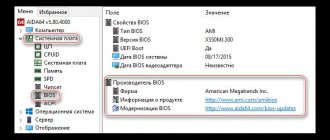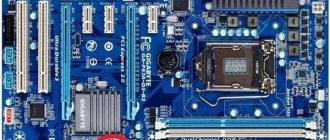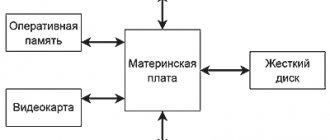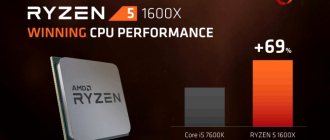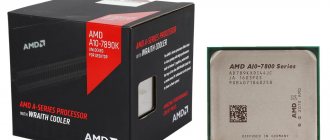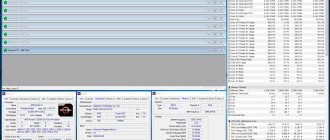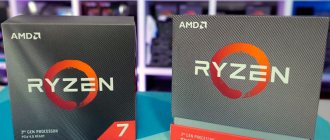general information
Along with the AMD Ryzen processors introduced in 2020, six chipsets were announced: AMD X370, B350, A320, X300, A300 and B300. A year later, Ryzen 2 processors appeared, and with them only one chipset was introduced, AMD X470, and later the B450 appeared. Compared to last year, this is not enough, but don’t be upset, because all AMD 300 series chipsets are compatible with the new 2nd generation AMD Ryzen processors. True, with a couple of reservations. Firstly, compatibility is achieved only after updating the BIOS, which is released by motherboard manufacturers. Fortunately, motherboards are not Android smartphones that can wait months for new firmware. And secondly, AMD B350 and A320 chipsets will not be able to fully unleash the capabilities of the flagship Ryzen 7 2700X. Boards with such chipsets will probably not be able to provide the maximum level of processor power consumption, and as a result, its maximum possible frequency will decrease. But everything is very individual for each board, and there will probably be exceptions.
Next, we will tell you in detail about each chipset separately, and before that we suggest that you familiarize yourself with the summary table with technical characteristics. It is also worth clarifying that the table shows the total number of connectors for processors and chipsets - recall that AMD Ryzen CPUs of the 1st and 2nd generations have their own USB 3.1 Gen 1 and SATA controllers. Also, do not consider the number of USB, SATA or M.2 NVMe ports given in this table as absolute. Motherboard manufacturers have been circumventing such chipset limitations for many years thanks to controllers from third-party manufacturers. These solutions are debugged so well that the difference in throughput between USB ports from the chipset and a third-party controller is unnoticeable. The table is large, so for easy viewing, click on the picture.
Best Mini-ITX Board: MSI B450I Gaming Plus AC
There are three contenders in this form factor: ASRock B450 Gaming ITX/AC, MSI B450I Gaming Plus AC and Asus ROG Strix B450-I Gaming. The ASUS model looks good, but is too expensive. At $150, it doesn't stand out too much from its competitors.
The $120 MSI model contains a more powerful three-phase VRM with redundancy. The weak point is the SoC VRM, so an ASUS board is better suited for working with APUs, but not at this price.
The model from ASRock offers a 3 + 2 VRM, which for some reason the developers call 8-phase. The MSI board costs $10 less and seems like a more attractive option.
Source: www.techspot.com
AMD X470
The newest and coolest chipset, the first set of system logic chips from the 400 series of AMD. However, in terms of its characteristics, it largely repeats its predecessor, the AMD X370. These two chipsets have the same number of supported PCIe lanes, as well as USB and SATA ports. Overclocking the processor is, of course, available.
The differences between the AMD X470 and X370 go much deeper than the banal set of PCIe lanes and supported ports. AMD X470 received StoreMI technology. Using the latter, you can turn an SSD drive into a smart cache system for your hard drive. When using StoreMI, SSD and HDD will turn into one, single volume. And when you subsequently add disks, you won’t have to rebuild the array or rearrange Windows from scratch.
AMD X470 also has one advantage. Motherboards with this chipset received an improved power subsystem, which will help the new Ryzen 2 processors work more stable both under normal conditions and when overclocked. In addition, boards based on the new chipset have changed the layout of the RAM slots, which will help a system with two DDR4 modules work more stable, and when overclocking the RAM, get the best results.
AMD B450
The AMD B450 system logic set was officially unveiled at the end of July 2020. It is positioned as a more affordable alternative to AMD's flagship X470 chipset. This chipset supports CPU overclocking, AMD StoreMI, and allows for multi-card configurations with AMD GPUs. But NVIDIA SLI is no longer supported.
As for the differences between the AMD B450 and X470, they are minimal. In addition to the lack of SLI support already mentioned above, the AMD B450 chipset has 4 fewer USB 3.1 Gen1 ports than the current flagship X470.
Computex 2020: a scattering of AM4/B450 motherboards
Motherboard manufacturers ASRock, ASUS, Gigabyte and MSI presented their products based on a combination of the AM4 processor socket and the B450 chipset at Computex 2020. The new products support any AMD processors in the AM4 design and will debut in retail in one of the summer months. Let us recall that the B450 system logic set differs from the existing B350 in its expanded support for dynamic overclocking technologies.
ASRock B450
ASRock engineers have prepared unassuming motherboards for the exhibition in Taipei that combine everything necessary for assembling high-performance PCs. The B450 Gaming-ITX/ac Mini-ITX form factor model stands out with its elegant layout. It includes an AM4 connector powered by a “6 + 2” phase circuit, a B450 chipset covered with a small heatsink, a PCI Express 3.0 x16 slot for a video card, two DDR4 DIMM slots (with support for DDR4-3466 modules), four SATA 6 Gb/s ports. s and an Ultra M.2 connector (32 Gbit/s) for high-speed SSDs located on the back of the board.
The network capabilities of the ASRock B450 Gaming-ITX/ac are represented by a Wi-Fi (802.11ac)/Bluetooth 4.2 adapter and a Gigabit Ethernet interface. The audio subsystem is based on an 8-channel Realtek ALC1220 controller with support for Creative Sound Blaster Cinema 5 software. On the rear panel of the motherboard, among other connectors, there are USB 3.1 types A and C, a pair of USB 3.0, DisplayPort and HDMI video outputs, and sockets for Wi-Fi antennas.
The ASRock B450 Gaming K4 model of the ATX form factor allows you to connect six PCI Express expansion cards, including two AMD Radeon video cards (CrossFire in the “x16 + x4” scheme) or one NVIDIA GeForce. Another interesting feature of the new product is the ability to install two M.2 SSDs, however, the throughput of the lower connector is limited to 20 Gbit/s. The board implements a “6 + 3”-phase power supply system for the AM4 socket and there are three radiators, and the chipset one looks larger than two VRM coolers combined.
The B450 Gaming K4 has four DDR4-2133/…/3200 RAM slots, six SATA 6 Gb/s connectors, internal USB 3.0 pin, Realtek ALC892 audio codec and Realtek RTL8111 series network controller. When installing an APU, simultaneous image output via DisplayPort, HDMI and D-Sub is possible. In addition, on the rear I/O panel there are four USB 3.0 ports, a single USB 3.1 Type-A and Type-C.
The ASRock B450 Pro4 is an analogue of the B450 Gaming K4 without backlit elements (which ones are difficult to determine). Some restrictions are possible at the UEFI level in order to force potential buyers to pay attention primarily to the “gaming” board.
The ASRock B450M-HDV motherboard is made in the Micro-ATX form factor. It is a budget solution with a non-standard bottom location of the chip and chipset heatsink, a 4-pin additional power connector (ATX12V) instead of an 8-pin (EPS12V) and one heatsink for VRM transistors instead of two. The modest arsenal of the B450M-HDV prototype includes “4 + 3” power phases of the AM4 socket, two connectors for DIMM DDR4-2133/…/3200 memory modules, single slots for PCI Express x16 and PCI Express x1 expansion cards, four SATA 6 Gb/ s and an Ultra M.2 slot with a bandwidth of 32 Gbps.
The network controller and audio codec for this board are the most common (Realtek RTL8111 Series and ALC887, respectively); the PCB has pin connectors USB 3.0, USB 2.0 (at least 2 pcs.), COM, LPT and others. The rear panel provides HDMI, DVI-D and D-Sub video outputs, and four USB 3.0 ports, but there are no high-speed USB 3.1 connectors.
ASUS B450
ASUSTeK Computer brought three AM4/B450 motherboards to the home exhibition - ROG Strix B450-F Gaming, Prime B450-Plus and Prime B450M-A. The choice of gamers and enthusiasts with tight wallets will certainly be a representative of the ROG Strix family. It is made in the ATX form factor and is distinguished by the presence of three slots for video cards, the ASUS Aura RGB lighting system and the SupremeFX S1220A audio subsystem. The transistors of the “4 + 4”-channel power supply circuit of the AM4 socket are cooled by two radiators. The rear I/O panel is covered with a decorative casing with the series logo.
The device allows you to install up to 64 GB of DDR4-2133/…/3200 RAM, six PCI Express expansion cards (including two or three Radeon video cards or one GeForce), two M.2 SSD drives, six SATA drives, and also use pin USB 3.0, connectors for LED strips, liquid-liquid system pumps and fans. Among other things, the PCB contains a Realtek ALC1220 audio codec and an Intel Gigabit network controller. The rear panel of the ROG Strix B450-F Gaming has at least three USB 3.0 ports, two USB 3.1 Type-A, a single USB 3.0/3.1 Type-C, DisplayPort and HDMI video outputs, and other connectors.
Those who want to save a little can pay attention to the ASUS Prime B450-Plus motherboard of the same form factor (ATX). It is practically devoid of external frills and does without many of the components that the ROG Strix B450-F Gaming has - a pair of power phases for the AMD AM4 socket, massive VRM heatsinks (the shape of the heat sinks in general leaves much to be desired), a lower PCI Express x16 slot (works like x4 or x1), one of the M.2 connectors, the original RGB backlight, a rear panel casing and a DisplayPort video output.
The board has six power phases for the processor socket, four slots for memory modules DIMM DDR4-2133/…/3200, a pair of PCI Express 3.0 x16 (lower - [email protected] ), three PCI Express 2.0 x1 slots, M.2 Key M slot (32 Gb/s), six SATA 6 Gb/s ports and Realtek RTL8111H and Realtek ALC887 controllers, responsible for the wired network and sound, respectively. The rear I/O panel contains connectors for DVI-D, USB 3.0/3.1 Type-C, HDMI, USB 3.1 Type-A (2 pcs.), USB 3.0 Type-A and others.
Micro-ATX board ASUS Prime B450M-A is approximately in the same price category (5500–6500 rubles) as the Prime B450-Plus described above. It is less suitable for overclocking Ryzen processors, since it does without transistor heatsinks. On the other hand, the Prime B450M-A only needs a small body. There is nothing supernatural in the characteristics of this model: it is stated that there are six power channels for the CPU socket, support for DDR4 memory with an effective frequency of up to 3200 MHz, the ability to install an M.2 SSD (one M.2 Key M slot is available), PCI Express expansion cards (including discrete video adapter) and SATA drives (six 6 Gb/s ports).
The network and audio subsystem of the Prime B450M-A board are based on the same controllers as the ATX board Prime B450-Plus. The sound path in both cases is isolated. The configuration of the rear I/O panel is only partially known; in particular, it is stated that there are two USB 3.1 connectors, at least four USB 3.0 connectors, D-Sub, DVI-D, Mini-Jack connectors, etc.
Gigabyte B450
Gigabyte Technology brought one motherboard with an AM4 socket to Computex 2020, but, at least externally, it can give a head start to the vast majority of competing products. The device was named Gigabyte B450 Aorus Pro WiFi, its form factor is easy to guess - ATX. The manufacturer spared no metal for five radiators: the top ones cool the transistors in the VRM area, the bottom ones cool the chipset and M.2 drives (if, of course, two M.2 SSDs are installed in the system).
At the top of the motherboard, a “6 + 5”-channel power supply system for the processor socket is implemented, which promises good overclocking. Nearby are four slots for DIMM DDR4 RAM with dual-channel access, to the right is an ATX power connector and two of the six SATA 6 Gb/s ports. A decorative shroud with an illuminated Aorus logo hides rear I/O panel configuration details.
Despite its impressive dimensions, the B450 Aorus Pro WiFi has only four slots for PCI Express expansion cards. The top one operates in x1 mode, below it are PCI Express 3.0 x16 reinforced with a metal frame, full-size PCI Express 2.0/3.0 [email protected] and PCI Express 2.0/3.0 [email protected] Among the pin connectors, we highlight USB 3.0, connectors for LED strips and pumps SJO. The motherboard's audio subsystem is based on an 8-channel audio codec (most likely Realtek ALC1220) and includes "audio capacitors" and a headphone amplifier. Along with the Gigabit Ethernet interface, the new product is equipped with a combined Wi-Fi/Bluetooth adapter.
MSI B450
Our story about prototype motherboards based on the AMD B450 chipset ends with a selection of models made by Micro-Star International. There are actually two of them - MSI B450 Tomahawk and B450-A Pro. The first is accompanied by the slogan “Conquer the battlefield” and belongs to the category of gaming products, the second is said to be “stronger than steel” and looks simpler. Both boards are made in the ATX form factor.
For the B450 Tomahawk, a 26% increase in the area of VRM heatsinks and a reduction in the temperature of transistors in the power circuits of the AM4 connector by 10 ° C are declared (probably in comparison with the B350 Tomahawk). This step can only be welcomed, although we are still waiting for the re-advent of simple plate or needle aluminum radiators without painting as VRM coolers.
The arsenal of the motherboard in question is not rich enough for a flagship (within the AM4/B450 family) solution, so it is possible that the matter will not be limited to just “tomahawk”. The PCB contains nodes of the 5- or 6-phase power supply system of the AM4 socket, four slots for DDR4 memory modules with an effective frequency of at least 3200 MHz, PCI Express 3.0 x16 and PCI Express 2.0/3.0 connectors [email protected] (CrossFire according to the formula " x16 + x4"), a trio of PCI-E 2.0/3.0 x1, six SATA 6 Gb/s ports (the prototype has four) and a single M.2 Key M with a bandwidth of 32 Gb/s. The audio controller is supplied by Realtek; the model of the Gigabit Ethernet network controller is unknown.
The rear panel of the MSI B450 Tomahawk, among other things, contains DVI-D and HDMI video outputs, two USB 3.0 ports, single USB 3.1 Type-A and Type-C.
MSI B450-A Pro offers similar capabilities, although the circuit design of the boards is not the same. The version with the Pro prefix has an additional PCI-E 2.0/3.0 x1 slot and, at the same time, the chipset heatsink is significantly reduced (at least at the prototype level). On the rear panel, USB 3.0 ports (4 in total) took the place of USB 3.1 ports, and analog D-Sub was added to the DVI-D and HDMI image output interfaces.
Note that all prototypes of AM4/B450 boards presented in this material will, in their capabilities and design, completely or almost completely correspond to their serial counterparts.
AMD X370
The flagship chipset for 1st generation Ryzen processors remains a relevant solution, despite the existence of the AMD X470. Motherboards with AMD X370 are suitable for two generations of Ryzen CPUs; they can also be used to assemble configurations with multiple NVIDIA and AMD video cards.
In addition, the AMD X370 chipset will allow you to assemble bundles from AMD and NVIDIA video cards, and create RAID arrays of types 0, 1 and 10. This chipset also supports processor overclocking - after all, it was created for enthusiasts.
MSI B450 Tomahawk
If we consider the best motherboard in terms of price and quality ratio, then we can safely recommend the MSI B450 Tomahawk. It combines all the best from expensive boards, complementing it with a pleasant price. It seems that these are just fantasies, but they are more than real! Yes, even this motherboard will not be able to fully match the power of top-end analogues, but this does not prevent it from being approximately on the same level with them.
It's worth noting right away that this is far from the cheapest board, but it pulls out all the Ryzen processors, so the couple of extra thousand you spend on its purchase will completely pay for itself. By the way, the use of powerful components is mandatory, because a powerful motherboard will not be able to cover the reduced hardware!
AMD B350
The next chipset, AMD B350, is designed for creating ordinary home or office PCs. It has slightly fewer PCIe lanes, as well as USB and SATA ports, than the AMD X370 or X470. However, even such a chipset allows you to overclock the processor - this option was not removed from the AMD B350.
However, the shortcomings of the AMD B350 chipset should not be taken seriously. A motherboard with such a set of system logic can even accommodate two video cards operating in Crossfire mode. But the second card can only be connected to a PCIe 3.0 slot with four lanes. In addition, motherboard manufacturers can increase the number of USB ports using controllers from third-party companies.
AMD X300
Performance PCs in a small form factor will always be the ultimate dream of many enthusiasts. It is for them that the AMD X300 chipset was created. It is designed for installation in the smallest motherboards, and at the same time allows you to overclock the processor, and at the same time supports CrossFire. True, how to place two top gaming video cards on a small Mini-ITX motherboard remains a mystery, the solution of which was left to the conscience of motherboard manufacturers.
The AMD X300 has one more feature. It does not have native support for SATA and USB, so only the port controllers installed in AMD Ryzen processors will be used when using it. The X300 also communicates with the processor using a separate SPI interface, so the processor frees up 4 more PCIe lanes. Typically these lines are used to connect the processor to the chipset, but in the case of the AMD X300 they can be used to connect additional M.2 drives, local network, Wi-Fi modules and other devices. In general, everything in the AMD X300 chipset is good, but motherboards in which it would be installed are not found in stores. But you can find Mini-ITX solutions with B350 and even X470 chipsets.
B550 and B550A - easy to get confused, but the differences are significant
announcements and advertising
2080 Super Gigabyte Gaming OC for 60 rubles.
Compeo.ru - the right comp store without any tricks
RTX 2060 becomes cheaper before the arrival of 3xxx
Ryzen 4000
series included in computers already in Citylink
The price of MSI RTX 2070 has collapsed after the announcement of RTX 3xxx
Core i9 10 series is half the price of the same 9 series
The price of memory has been halved in Regard - it’s more expensive everywhere
An inexperienced user who has just begun to understand the specifics of chipsets for the AM4 platform can easily confuse two chipsets that are so similar in spelling, but completely different in essence - B550 and B550A. You also cannot exclude the possibility that you came across this article and have never heard of the B550A chipset before, since you were not in the know to this day. Anyway, the main and most important difference between these two chipsets is that the B550A chipset is a renamed B450 chipset aimed at AMD's OEM partners. That is, it has nothing to do with the latest AMD chipsets, and supposedly the 500 series means in this case only that this chipset belongs to the new line.
In principle, since motherboards based on the B550A chipset cannot be purchased by the average user in our retail stores, you should not be afraid that you will accidentally confuse the chipsets with each other when purchasing a motherboard.
In turn, the B550 is a truly new chipset from AMD, scheduled for release on June 16, 2020. Boards based on this chipset will appear in retail sales only by July of this year, if not later.
